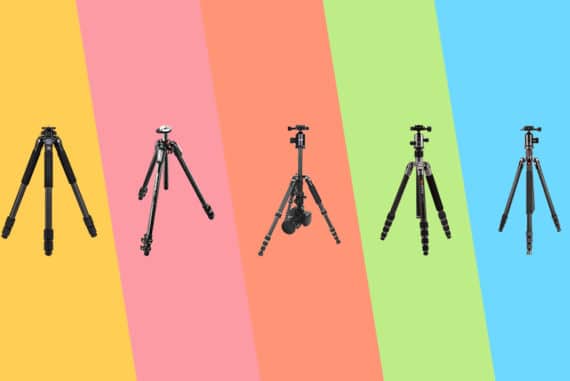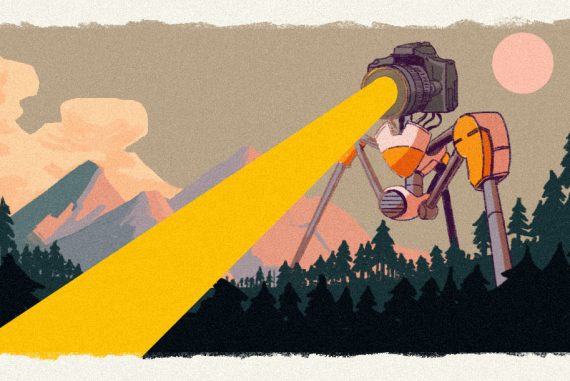
Best Monopod for Camera Owners in 2024
Discover the best monopods for cameras in our comprehensive guide, featuring top picks that combine durability, flexibility, and ease of use for photographers.
Camera Gear Guides | Tripod & Monopod Guides | By Don Machuca | Last Updated: February 12, 2024
After several years of Shotkit articles, I’ve finally finished writing one on the best monopod!
Our humble one-legged friend isn’t the first thing on most photographers’ wish lists…
It wasn’t until quite recently that I’d actually used a monopod for my photography.
I’ve always known of their existence, but their usage… well, it was all a bit baffling to me!
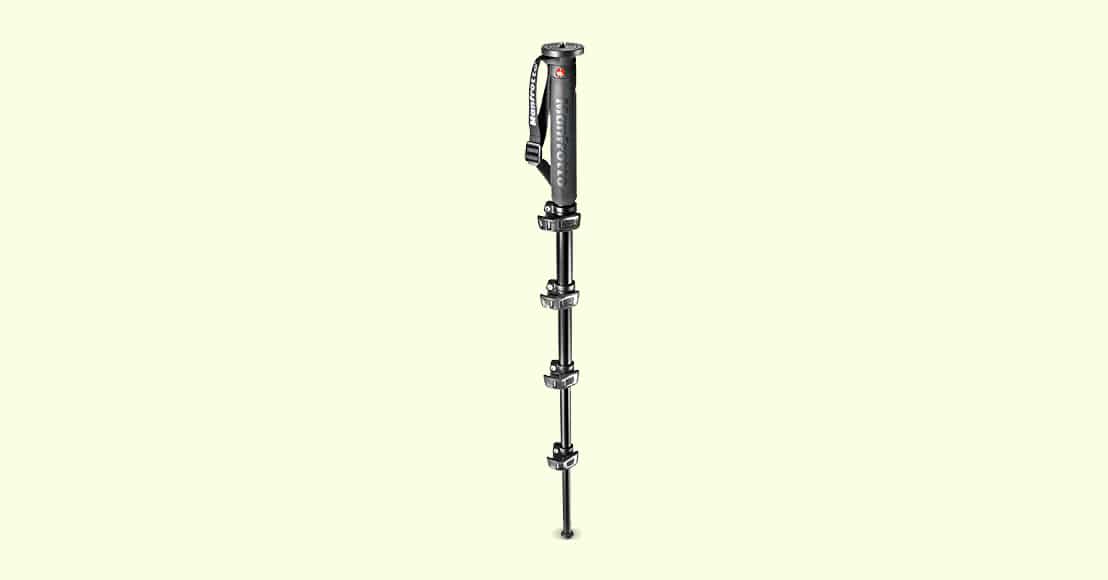
Offering premium camera support without the bulk, this monopod is sturdy, light, and easy to set up.
This review has been something of a revelation in my professional photography career.
Being forced to review several of the top monopods and put them to use in real-life situations, has brought a new appreciation for these unique products.
I’m now convinced that while a monopod may not be the first thing to recommend to a photographer, it’s definitely one of the tools that should be considered, whatever your level.
(It’s also fortunate that they’re usually much more affordable than other camera accessories.)
In this guide, I’ll be showcasing what I consider to be the best bang-for-the-buck monopods, as well as highlighting why you’d actually want one in the first place – are monopods better than tripods?
What is the Best Monopod for Camera Owners in 2024?
| Image | Product | Features | |
|---|---|---|---|
 | Manfrotto XPROOUR #1 CHOICE |
| View Price → |
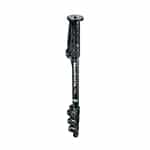 | Manfrotto 290GREAT VALUE |
| View Price → |
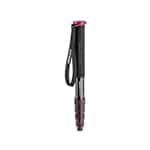 | Manfrotto ElementBEST BUDGET |
| View Price → |
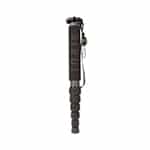 | Sirui P-306 |
| View Price → |
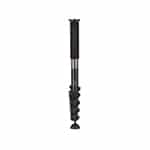 | Benro Adventure 4 |
| View Price → |
1. Manfrotto XPRO
Extended: 139.7 cm (55 in.)
Retracted: 41 cm (16.1 in.)
Weight: 700 g (1.54 lbs)
Material: Aluminium
If you’re in the market for a premium camera support but would like to cut down on bulk, you may want to check out Manfrotto’s XPRO monopod lineup.
With different monopods included in the range, it’s more than likely that you will be able to find something that works for you.
One in particular, the Manfrotto XPRO aluminum 5-section monopod, is worth a closer look. This camera support is a great thing to have if you’re travelling as it is very light and compact and therefore very easy to lug around.
At just 1.54 pounds (.7kg) and 16.14 inches (41 cm) fully closed, the aluminum XPRO is very handy. Yet, this doesn’t mean that you will have to trade weight for functionality as it stretches out to a generous 55.51 inches (141 cm) and is capable of supporting over 13 pounds (5.8 kg) of payload safely.
If sleek is more your thing, you can opt for a version of the carbon fiber version of the XPRO monopod. While certainly adding bling, that’s not all it provides. At 1.37 pounds (.62 kg), it’s a little bit lighter than the aluminum version and has more reach. This makes this a good contender for the best carbon fiber monopod.
Fully tucked in, the carbon XPRO is longer at just over 19 inches (48.3 cm) but, it makes up for this extra length by extending to over 69.3 inches (176 cm) or almost 14 inches (35.6 cm) more than the aluminum version. Note though, that it does have a lighter load limit of 11 pounds.
While both monopods have important differences, they share a lot of features as well. Both supports have a 3/8″ screw to connect to your choice of head but, this can be retracted to reveal a 1/4″ screw that lets you mount your camera directly.
Both XPRO monopods feature quick power locks that let the user deploy and adjust the legs rapidly (much like on this popular tripod). This lets the shooter achieve the best angles possible while staying clear of camera shake. They’re also fitted with a new rubber leg warmer design that’s supposed to make them easier, faster and safer to handle.
The XPROs are excellent for stills but if you also shoot video, you’ll be glad to know that both monopods are compatible with Manfrotto’s fluid heads as well as the FLUIDTECH base which adds a lot more stability.
These Manfrotto monopods provide exceptional performance and with a little care, can continue functioning well for a very long time. For such quality however, you can expect to pay a premium.
Priced at a hundred dollars for the aluminum XPRO monopod and over $200 for the carbon-fiber version, there are definitely cheaper options available but then again, as a long-term investment, these tools are worth the extra spend.
2. Manfrotto 290
Extended: 151 cm (59.4 in.)
Retracted: 49 cm (19.2 in.)
Weight: 500 g (1.1 lbs)
Material: Carbon Fiber
When you’re shooting on the go, mobility becomes just as important as the camera and lens you carry so you’re going to want to choose your gear carefully. Camera supports in particular, have a tendency to slow you down unless of course, you choose the right one.
If you need to be nimble, then the Manfrotto 290 monopods are just the thing. At just 1.1 pounds (0.5kg) for the carbon fiber version and 1.19 pounds (0.54 kg) for the aluminum monopod, you will hardly notice the extra payload so you can travel all day and not grow weary of lugging them around. This makes it one of the best best travel monopods.
Aside from the negligible weight difference and the fact that the carbon fiber 290 has slightly thinner segments, both variants of the 290 have identical specs. Fully closed, they measure 19.29 inches (49 cm) and open up to 59.45 inches (151 cm). They’re also both rated to carry 11.02 pounds (5kg).
Given the Manfrotto 290’s weight capacity, you’re going to want to use an appropriately matched camera and lens to ensure that you get the best performance out it. This means that if you use heavy gear, you’re probably better off getting something that’s more rugged.
The Manfrotto 290 monopod comes with a retractable 3/8″ screw that exposes a 1/4″ screw when pushed down. Such an arrangement allows you to attach a head to the support or, your camera directly if you want to avoid the weight penalty that comes with extra accessories.
Deploying and adjusting the 290 is easy as both models make use of a flip lock latches. These let you get ready quickly even in the tightest of spaces. The leg segments are also composed of D-shaped tubes that prevent the monopod from rolling away when propped against a wall or ledge.
Currently, the aluminum 290 sells for a little over 50 bucks while the carbon version comes in at just a little over 90 dollars.
While these prices won’t break the bank, there are certainly cheaper options available. However, if you’re looking for one that is reliable and will last for quite some time then, these are definitely the ones to invest in.
Besides, the brand does stand out so such an item would make a great addition to your kit.
While the Manfrotto 290 monopods are excellent tools, you have to keep in mind that they’re not for heavy duty use. Instead, they’re designed to help keep you light and highly mobile so you can take advantage of any photographic opportunity that comes your way.
3. Manfrotto Element
Extended: 150 cm (59.1 in.)
Retracted: 41.4 cm (16.3in.)
Weight: 500 g (1.1 lbs)
Material: Aluminium
If you’re looking for a camera support that you can take on your heavy DSLR and lens with ease, there are quite a number of pricey options available. However, if don’t want to splurge, but still would like something with a premium feel, then a Manfrotto Element monopod may be just the thing.
While you’d expect something from Manfrotto to be at the pricier end of the spectrum, this isn’t the case for the five leg sections Element. At around 40 dollars, this support is definitely something that wouldn’t require much deliberation.
The Manfrotto Element comes in red and black (which is priced a bit higher) and features aluminum construction. It is very light at just 1.1 pounds (0.5 kg) so it won’t add much to your burden. This is an important thing to consider especially if you already have your hands full carrying all your other gear.
Light as it is, the Manfrotto Element can take a lot of weight. With its maximum safe payload being 33 pounds (15 kg), it is more than strong enough to take on a full-frame DSLR with a grip, a telephoto lens and even a speedlight attached. This makes it the best monopod for wildlife photography as it easily supports heavier zoom lenses.
The Element opens up to a generous 59 inches (150 cm) so a user whose height falls in the average range should be fairly comfortable with it. When fully closed, it measures just 16 inches (41cm). This means that it will fit in a normal backpack and won’t complicate the task of getting around.
One thing you will notice is that it does not have flip locks like other monopods. Instead, it makes use of twist locks to secure each of its five sections in place. This makes it a bit slower to deploy but, then again, twist locks are quite secure so you won’t have to worry about it collapsing unexpectedly.
As far as mounting goes, the Element has both 3/8″ and 1/4″ screws. But, unlike pricier models that come with retractable screws, you’re going to have to manually flip to 3/8″ if you’re attaching a head or 1/4″ if you’re mounting a camera directly.
The top section of the monopod comes with a leg warmer that helps improve handling by enhancing your grip. This means that it is less likely to slip from your hands. It also comes with a wrist strap that keeps it securely tethered to your arm.
To add to safety, the Element comes with a metal spike that’s replaces the monopod’s standard foot. This accessory is meant to help anchor the support on soft surfaces like soil and keep it from slipping.
Though it is a bit more cumbersome to use than a fast-deploying flip-lock monopod, the Element is nonetheless, a very good buy. For its price and for what it can do, not to mention the prestige of its branding, grabbing one for your kit is a very good idea.
4. Sirui P-306
Extended: 152.4 cm (60 in.)
Retracted: 38.1 cm (15 in.)
Weight: 5oo g (1.1 lbs)
Material: Aluminum
If you’re on the hunt for an excellent monopod that’s budget friendly, then you should definitely check out the Sirui P-306. Priced a little under 60 bucks, this monopod certainly gives a lot of value for money and can definitely hold its own against competing products.
At just 1.1 pounds (.56kg) the P-306 isn’t what you’d call heavy. In fact, for what it can do and how much it can carry, it’s probably something that you’d want to have around every time you’re out shooting. It is very well-built and is capable of hoisting 17.6 pounds (8 kg) of weight so attaching a full-frame DSLR with a big telephoto zoom isn’t out of the question.
Unlike many other monopods, the P-306 doesn’t have flip locks but this isn’t necessarily a bad thing. Yes, not having this feature means that the monopod may not extend or retract quite as fast but, then again, you can count on it to provide more peace of mind because the twist locks it uses won’t come undone accidentally.
This monopod is made up of six sections and extends to a maximum height of 60.6 inches (155 cm). This means that it can be comfortably used by most people including those who are shorter or a little taller than the average.
Bringing it around isn’t hard at all since it collapses down to just 15 inches (39 cm). This means that you can clip it onto the side of a backpack or shove it into a bag, thus ensuring that it never gets in the way while you’re on the move.
For added stability, the P-306 comes with a rubber foot that can be retracted to reveal a spike. This feature is very useful for shooting on soft ground as it will keep the monopod and its payload from slipping and falling.
Its top section aids in keeping things secure with has a rubber grip that allows for better handling. It also includes a wrist strap and carabiner/compass combo to ensure that the support remains firmly in your grasp and that you can keep yourself oriented properly.
If you’re planning on using it with a head, you will be able to do so thanks to the 3/8″ screw that it comes with. Additionally, you can flip this screw upside down to reveal a 1/4″ tread that will allow you to attach your camera directly to the monopod.
If the P-306’s features appeal to you yet, aluminum isn’t your material of choice, you can opt to get the carbon fiber version. Known as the Sirui P-326, this model comes in at around a hundred dollars and shares most of its specs with the aluminum version. It is lighter however at .99 pounds (.45kg) and has a higher load capacity of 22 pounds (10 kg).
5. Benro Adventure 4
Extended: 191 cm (75.2 in.)
Retracted: 54 cm (21.2 in.)
Weight: 830 g (1.85 lbs)
Material: Aluminium
If you’re on the taller side or are just looking for a strong, unobtrusive camera support with a lot of reach, then the Benro Adventure 4 Series monopods are what you need.
The Adventure 4 is available in aluminum and carbon fiber and both are capable of lifting a hefty 40 pound (18kg) payload. This is more than enough for even the heaviest DSLRs and lenses so you won’t have to risk overloading them and compromising the safety of your gear.
The aluminum model weighs in at just 1.85 lb (0.84 kg) while the carbon fiber version comes in at 1.37 lb (0.62 kg).
While slightly heavier than other monopods, the Adventure 4s are still unobtrusively light and won’t make much of a difference to your load. This is especially true if you’re carrying your heaviest, most capable equipment.
Like any other monopod, they come with both 3/8″ and 1/4″ screws that allow users to attach a head or, if need be, mount their camera directly to the support. For the Adventure 4s, this screw is flipped over to expose the thread required for the application.
Both of these monopods are composed of five sections. The aluminum variant extends to a maximum of 75.2 inches (191 cm) while the carbon fiber model stands slightly shorter at 72 inches (183 cm).
This makes them ideal for users who are taller than average as they will not have to stoop down to shoot.
They’re also ideal for those who want to take high angle shots without having to perch their gear precariously or rely on heavy, bulky tripods.
Fully closed, the Adventure 4s are even at 20.7 inches (52.5 cm) making them very easy to carry along, shove into a bag or strap to the side of a camera backpack (see reviews). Given their negligible weight, chances are, you won’t even notice they’re there.
Deploying the Benro Adventure 4 is quick and easy thanks to the flip locks that hold their legs in place. This feature allows a photographer to set up much faster and be ready to take advantage of any shooting opportunity that comes along.
They also come equipped with a closed-cell rubber sheath at their top sections to improve grip and handling.
Other monopods come with a rubber foot but, the Adventure 4 has something else. To keep them planted on the ground, Benro has opted to put in a swivel pod which lets users position at any angle without worrying too much about the stability of the footing. In addition, the they can also be fitted with an optional three-foot articulating base for added security.
At 70 dollars for the aluminum model and $155 for the carbon fiber variant the Benro Adventure 4 monopods aren’t the cheapest options available. But, given what they can do, they can certainly be considered a pretty good deal.
How to Choose a Camera Monopod
Due to the huge number of monopods on the market in 2024, I’ve tried my best to keep this selection brief and to the point.
I’m aware that there are many other more advanced monopods, featuring exotic materials, technical ball heads, rubber feet and much more, but for the majority of photographers, it’s unnecessary and over-priced.
Sure, if you’re a sports photographer who uses a monopod every working day to support your DSLR with 400mm lens, go get that latest $500+ model. That might be the best monopod for sports photography… but for the rest of us, the ones recommended here provide much better bang for your buck.
That’s not to say that any one them are cheap and nasty, however. One quick Amazon search for monopods reveals a slew of dubious quality models at bargain basement prices, made by a brand you’ve never heard of before.
I’d exercise caution with anything with a price that seems too good to be true – despite monopods not having a great deal of working parts, they still need to support your expensive equipment. Invest in something that will do it safely and securely!
Frequently Asked Questions on the Best Camera Monopod
What is a camera monopod used for?
A monopod is used to stabilise a camera to achieve a steady shot when taking a photograph. It can also be used to help distribute the weight of a heavy lens, or even to ‘pan’ the camera when photographing a subject in motion.
What is the best monopod?
Depending on your needs, there are different monopods to suit every photographer. Some may require extra-long monopods, or lightweight monopods, or even monopods with feet. Our number one all-round choice is the Manfrotto XPRO.
Why do I need a monopod?
If you need to stabilise your camera but don’t have the space for a fully extended tripod, a monopod can be the perfect compromise. Monopods are also smaller and lighter than tripods, and often cheaper too.
Does a monopod really help?
Monopods are one way to achieve a steadier shot than simply hand-holding your camera. You’ll be able to use a slower shutter speed, lower ISO, or smaller aperture, depending on your needs. Whilst obviously not as stable as a tripod, a monopod is great for times when you don’t have space or time to extend a tripod’s 3 legs.
Final Words
A monopod is one of those photography tools that you may not ever realise you need, but once you use one, you won’t be able to do without it.
From stabilising your shot in a crowded place, to providing a much-needed rest for your muscles when using long lenses and heavy camera bodies, I urge you to try using a monopod at least once.
Personally, I rarely shoot in crowded places where I need a stable shot, and I never use long, heavy lenses. However, I find my monopod invaluable to get a much higher vantage point when shooting large group photos at weddings.
Monopods are so compact and lightweight that you can leave one stashed away under the seat of your car, ready to deployed in an instant.
I hope you enjoyed this article. Happy snapping!

Offering premium camera support without the bulk, this monopod is sturdy, light, and easy to set up.
Don Machuca is a writer and professional photographer/videographer from Manila, Philippines who specializes in landscapes, events and product photography.









